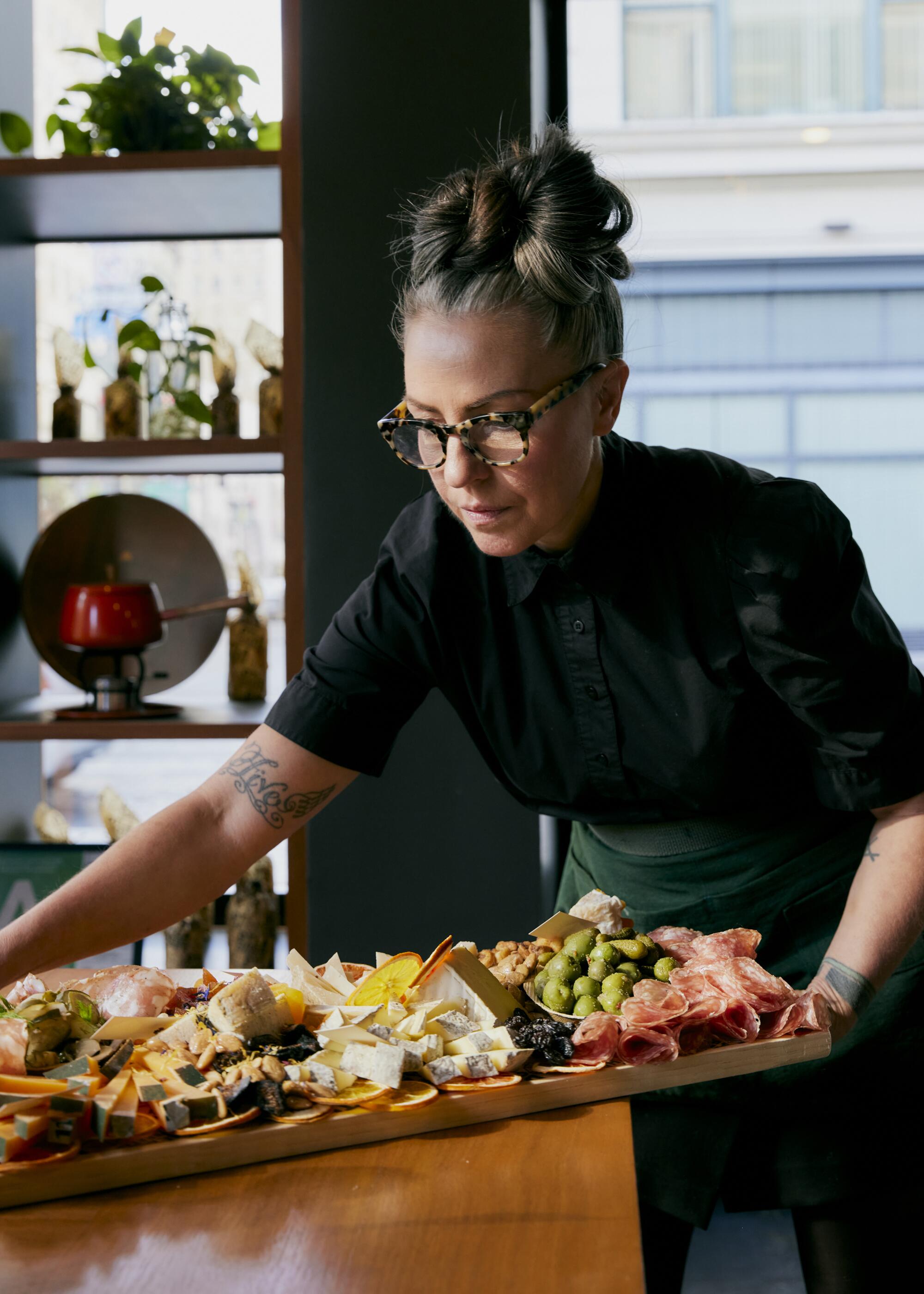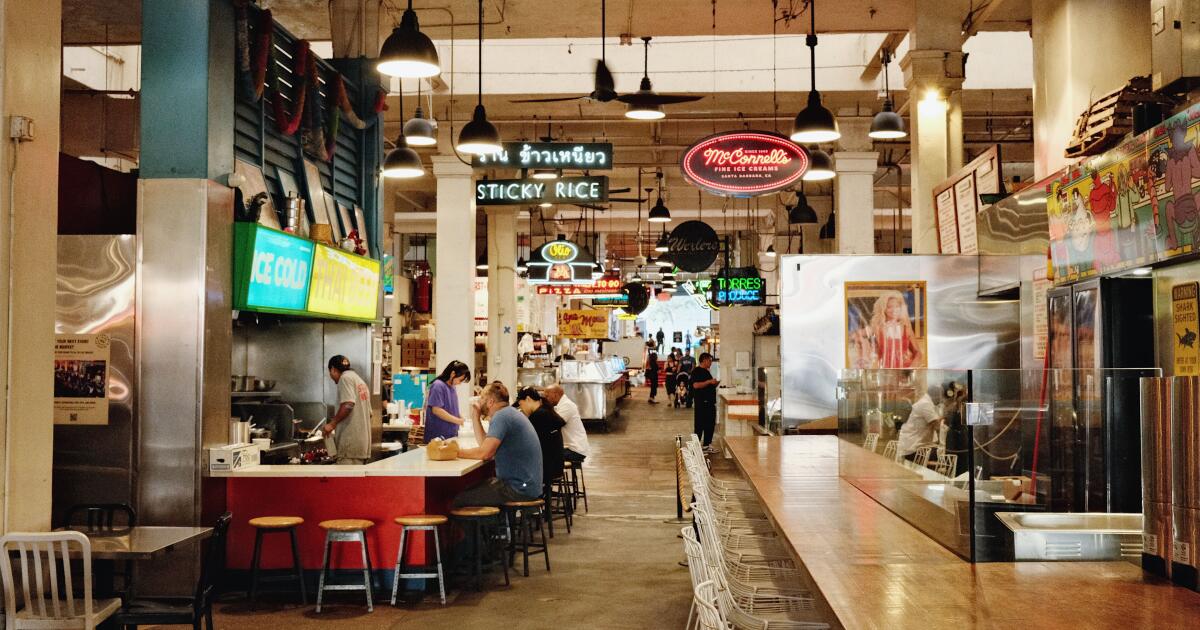On the week, most pedestrian traffic and business world are fixed in the Grand Central Market, and since 1917, the Grand Central Market, a staple of the historical core of the city center. In a way, the oldest stalls from Mexico to China, Salvadoran kitchens, their oldest stalls, are an example of the immigrant experience in Los Angeles.
However, this week, even during the most busy hours, the tables sat blank. Like many other restaurants and businesses in the city center, the legendary market is losing its business due to migration and customs enforcement raids and the anti -ice protests of the neighborhood.
In the afternoon of Thursday, Martha Luna helped scented guests under the iconic red neon signs in China Cafe, where he has been a server for more than 40 years. Founded in 1959, it is one of the oldest sellers in Grand Central Market.

For a long time, China Cafe server Martha Luna has been helping a lonely customer on Thursday.
(Stephanie Breijo / Los Angeles Times)
“The last few days, crazy,” he said behind the red bench. “Everyone is afraid, you know? When they come, they just talk about [how] They’re afraid to go out. Even if they go to the market and eating, even my boss is very scared. “
During last week, he said that he had been seen one to three regularly every day, and only one or two guests were sitting on the counter at any time.
Gündüz, office workers in the city center listing the wrap meter of squatting. In the evening, Luna said the customer is mostly tourists. Since 1959, sweet and sour chicken has come to Chinese American classics, such as pork in barbecue mein, egg rolls, chops and shrimp fried rice.
More new, more flashy sellers have also made a dramatic decline in the business world.
-
Share through
“We are typically one of the sellers who are very busy all week and day,” Amy Recinos said in Villa’s Tacos. It is not rare to see customers who prolong the length of the counter while waiting for crispy cheese and fresh blue corn bread layer.
Typically Taqueria – One of Los Times’s best 101 restaurants in Los Angeles – A “big” lunch in the market until noon is in a hurry, but this week Villa’s closes early due to lack of work.
Recinos said that most of them are working in the neighborhood and working from home to “avoid the uprising and avoid protests”.
On Sunday, he found most of the stand customers as protesters, and Recinos expects the situation this weekend to happen.
“For all my Spanish immigrants: I’m here for you, we see you,” he said. “I am very lucky to be born here and I am blessed, but I hope it is calming because it is not easy to know or guess what will happen for families and children. Just stay safe there and we are here for you if you need a meal.”
Bella Aguirre finished Pad Kra Pow dinner and sat on a stool on Sticky Rice’s counter. Targeted costume designer, considering the protests of his father’s warning against the dangers of the neighborhood came to the market with an out -of -city friend.
He said that he was “very peaceful ve and was looking forward to going back this weekend in the afternoon of Thursday.
“I think it is within our right to protest,” he said. “And I am looking forward to going to Saturday protests because I think people will have a bigger boom. I think I feel safe.”
Grand Central Market, said it looks slow compared to his previous visits.
Nearby stop He praised the Smashburger spot for winningYellow, a hand -written sign, “we will close early due to current events,” he said.
Sonya Mendoza, sitting on a patio with a laptop and a cup of green juice, said that the customers he regularly see on the market regularly. He said he was always in a hurry to lunch up to 3 afternoon. On Thursday, only a handful of customers passed or filled the nearby tables.
Mendoza’s work is less than a mile from the centers and Landmark Food Hall in the city center and Echo Park. He found Desolation was not limited to the Grand Central Market.
“There is no seller of a street seller, Mend Mendoza said. “I haven’t seen any street sellers in the last three days, which I live in Echo Park because they usually they are everywhere.”
In a corner seat in Lucky Bird’s Counter, Froi Cruz enjoyed the break of the frying chicken stops. He worked in the restaurant for five years and said it was now exhausted.
Customers gradually decreased during the week. Due to the curfew and slowing down, Lucky Bird closes around 17.00 two hours before the use of weekdays. This weekend may not come to the usual hours at 21:00.
Most of Lucky Bird’s customers are the office employees who order for sides such as fried chicken sandwiches, tenders, wings and cheddar jalapeño biscuits. This work was tricked into some of his old skin this week.
Orum I feel like people are afraid to go out, Cruz Cruz said.
Against the corridor, Jose Marroquin in Shiku reiterated these feelings. “Very slow,” he said. “There is no one, nothing.”
At the end of the block, the Grand Central Market’s decadelong vendor found its own brick and mortar position and was greatly influenced by the loss of work of the week, like the old Food Hall brothers.

Lydia Clarke is one of the owners of Dtla Cheese Superette.
(Jennelle fun)
DTLA Cheese Superette is based on nearby offices for lunch orders of sandwiches, salads and chartieri boards. The common owner and Cheesemonger Lydia Clarke said that all catering orders were canceled this week and it was difficult to balance. On Sunday, Clarke and his partner Reed Herrick served a series of protesters. On Monday, they noted that “stop immediately” for the job.
He described the lack of customers as “ruthless ve, and he wondered how DTla Cheese Superette or the adjacent bar Kippered would take a ban on icing and the remote operation of the neighborhood due to ice -pre -ice protests.
For a long time in the city center, Clarke sees that it serves the community to help protesters and hopes to maintain it as much as possible.
“We feed many people walking on the sidewalk and hearing the story and being supported in this way is great: great to give a nutritious support [for] Our community and reasons, Clar Clarke said, tearing. [in the] Industry, our food resources, our labor force. I have no fear of being taken, so I feel broken for these families. It is an honor to stand here and to open our doors and to have a place for people to come. “
Times personnel writers Lauren NG and Karla Marie Sanford contributed This report.




